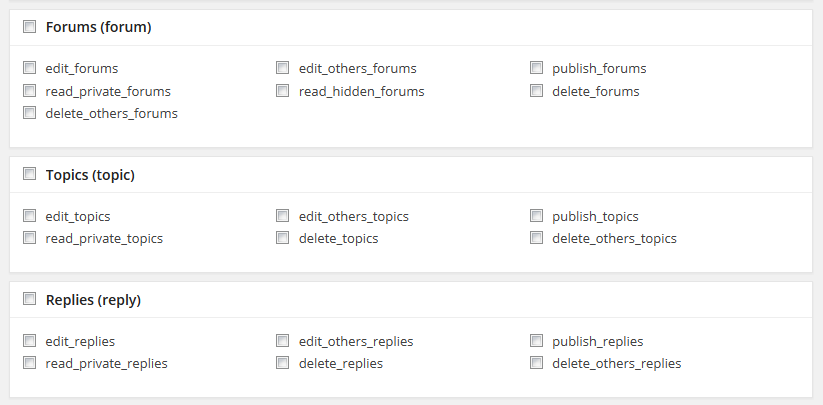WPFront User Role Editor allows you to create capabilities for custom post types available within your site. When a custom post type is created within WordPress, by default it uses “Posts” capabilities. What that means is, lets say you have a custom post type called “Demo”, whoever has the capability to edit posts, will also have the capability to edit demos. You cannot have a capability enabled for post but the same capability disabled for demo.
Some plugins create custom post types within your site with its own capabilities. For example bbPress creates three custom post types. Forums, Topics and Replies with its own capabilities. When a custom post type has its own capabilities, WPFront User Role Editor will display a section for the custom post type within the Add/Edit role screens (except in multisite screens, since multisite doesn’t load custom post types by default).

When a custom post type has its own capabilities WPFront User Role Editor will not allow you to customize it, because doing that could break the functionality of the plugin/theme. Also it doesn’t make sense to customize something which already has custom capabilities. But you will still be able to use Extended Permissions on them.
If a custom post type can be customized, you will see a section like below within the Add/Edit screens.

Also within the settings screen under “Customize permissions”.

A custom post type will only be available to customize if it has the “show_ui” attribute enabled. If this attribute is disabled, that means either that custom post type is for background use or it has a custom UI on it.
To enable custom capabilities for a custom post type, you need to enable it under settings. Once you have the setting enabled, you will see custom capabilities for the custom post type under Add/Edit screen.

You will see the same capabilities a post has, but customized for demo post type. These capabilities has the same meaning as the post capabilities. When you enable the setting, these capabilities are populated with the corresponding post capabilities. For example, whoever had the permission to ‘edit_posts’, will also have the permission to ‘edit_demos’.
Extended Permissions
Just like posts/pages, custom post types also have extended permissions. Extended permissions are available for post types which can not be customized too. When a custom post has extended permissions, a new role capability is added to enable or disable the extended permission management. You will see those capabilities under the “Roles” section. These work just like the post/page extended permission capabilities.

To learn how to use extended permissions, take a look into Posts/Pages Extended Permissions.
Topics
Posts/Pages Extended Permissions
Media/Attachment File Permissions
Content Restriction Shortcodes
